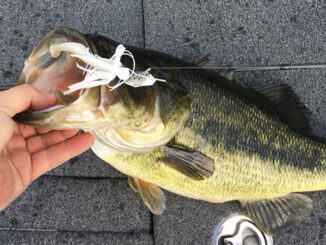
Largemouth bass are sight feeders. True. You have probably heard that they also can locate prey in the dark by using their lateral line system. Also true. But locating prey is only the start of the feeding process. Next, the bass has to capture the prey.
How bass capture prey
Largemouth bass capture, meaning ingest or get into their mouth, prey two ways: ram feeding and suction feeding. Ram feeding is overtaking prey with mouth open. Suction feeding is quickly opening the jaws and enlarging the mouth cavity by lowering the tissues on the bottom of the mouth to create negative pressure that sucks water and the prey into the mouth cavity. Indeed, a single feeding event is rarely all ram or all suction. Even with ram feeding, some amount of suction occurs in the last few milliseconds before the bass overtakes its prey.
Ram feeding will be predominate when bass are feeding on forage like shad in open water, or maybe when they crush a crankbait, swimbait, or jerkbait.

Capture of crayfish or a bottom-hugging fish will be mostly suction feeding. The light tap or the twitch in the line when they suck up a soft plastic from the bottom is probably suction feeding.
A bass blows up on a topwater. That’s mostly ram feeding. But sometimes they just sip it from the surface: suction feeding. But how a bass detects prey also determines how they capture it.
How bass detect prey
While the sense of smell may play a minor role, vision and the lateral line system are the bass’ dominant senses for detecting prey. Both senses are used simultaneously to maximize feeding success by a healthy bass in moderately clear water and in the daylight, but bass can feed successfully relying only on vision or only the lateral line.
Proving this is simple. Bass in a tank in a completely dark room can feed using only the lateral line system. Chemically block the receptors of the lateral line system (non-toxic cobalt chloride blocks neural transmission from the lateral line sensory cells without blocking any other neural transmission) and a bass in a lighted tank will feed. Bass in a dark tank with chemically blocked lateral line system will not feed.
A little bit on fish anatomy may help you understand how the lateral line system is involved in feeding. Most anglers have observed the lateral line as a slightly arched line on each side of the bass from behind the gill covers to near the tail. What you are seeing is a line of scales with pores (small holes) that allows water to flow into the lateral line canal; the sensory cells that detect the water movement are in the canal.
Not visible without magnification and careful searching is an elaborate system of lateral line canals on the head and jaws of the bass. A bass may get some information about nearby prey, and especially potential predators, from the sensory cells on its side; but it is the lateral line system on the head of the fish that provides fine-tuned information about the position of the prey. The system is sensitive enough for a bass to track a prey fish by the turbulence trail it produces as it swims.
Maximizing prey capture
University of South Florida researchers Drs. Jayne Gardiner and Philip Motta discovered that the mechanics of how bass actually capture prey can differ depending on which sensory modality — vision or water movement (lateral line) — is in operation. The study measured the capture of mosquitofish by four- to-five inch largemouth bass.
Strike distance was shorter and strike velocity was slower when bass could not see. Using infrared light, which bass cannot see, and high-speed videography, the researchers measured numerous variables associated with approach to the prey and when the mouth opened to create suction.
The simple summary is that bass without vision relied more on suction feeding, whereas bass without lateral line sensory information relied more on ram feeding. Ram feeding was even more prevalent for bass that received both vision and lateral line information.
Bass are extremely well adapted for feeding in a range of light conditions, including total darkness. What I, as a biologist, find fascinating is that bass use a range of options to best achieve successful prey capture depending on the sensory input.
What I, as an angler, find fascinating — but also a bit intimidating — is that the final act of capturing the prey occurs in only 30 to 40 milliseconds, roughly one thirtieth of a second. If you think you have a fast hook set, think again.


